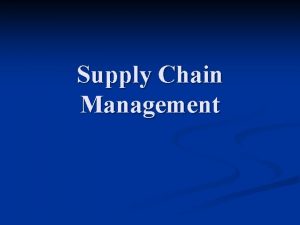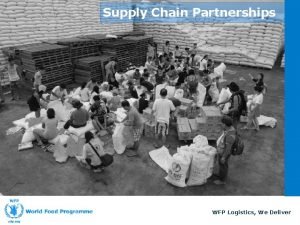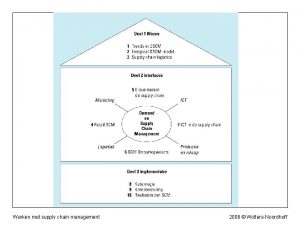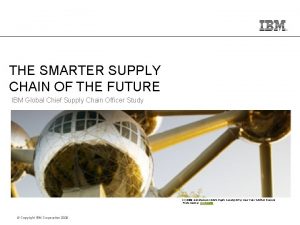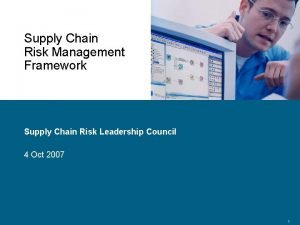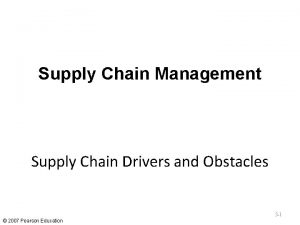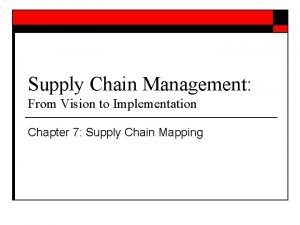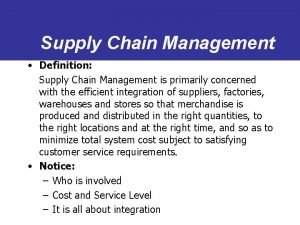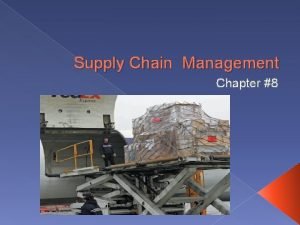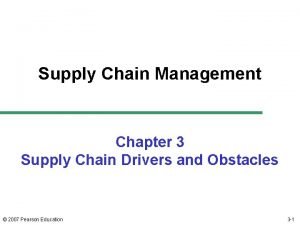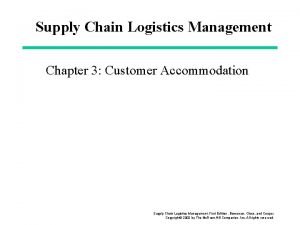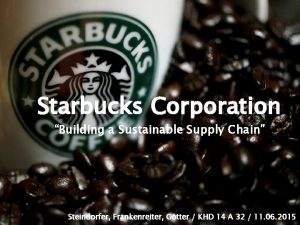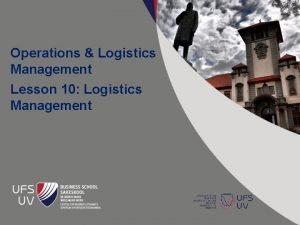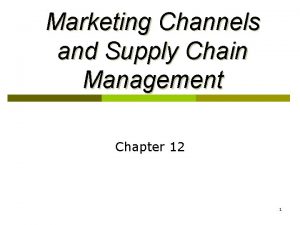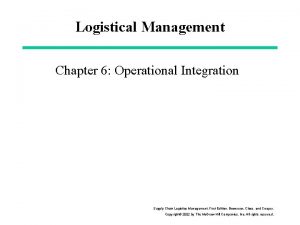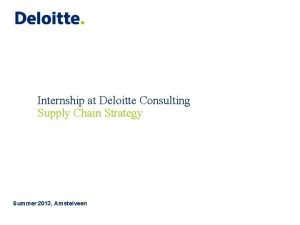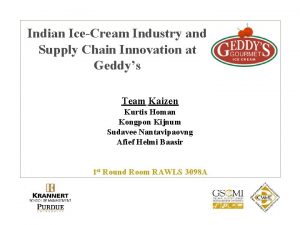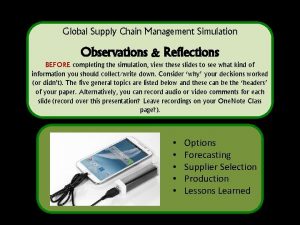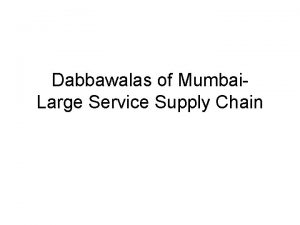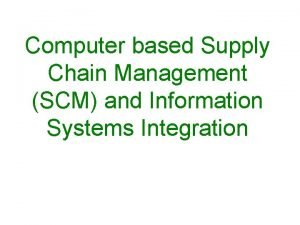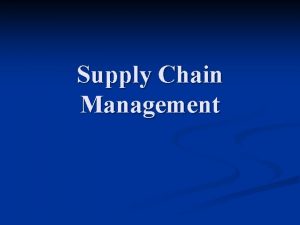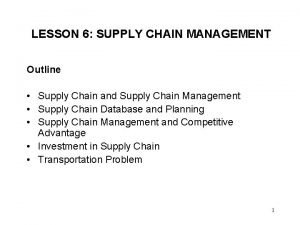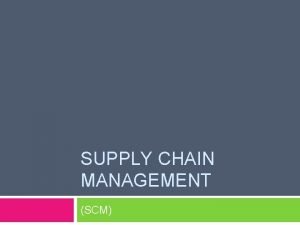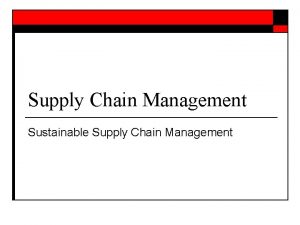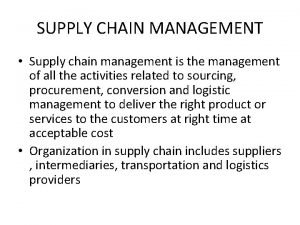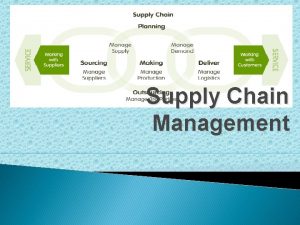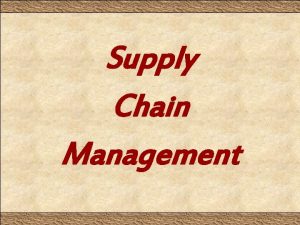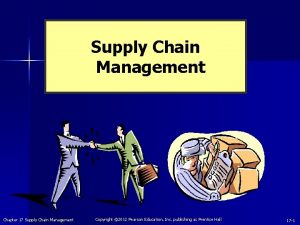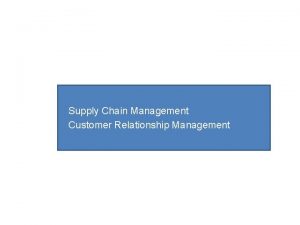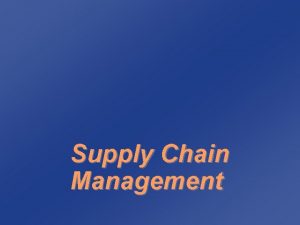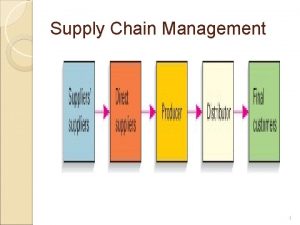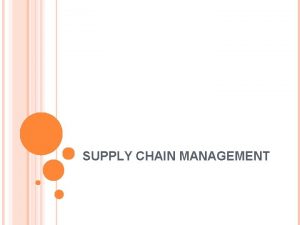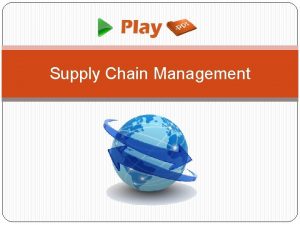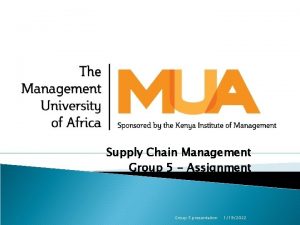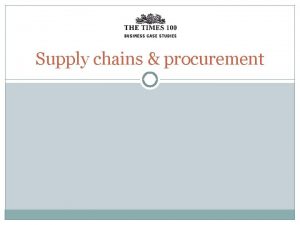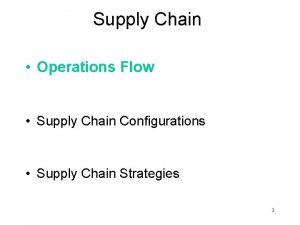Lesson 20 Supply Chain Management a supply chain





























- Slides: 29

Lesson 20 Supply Chain Management a supply chain is a sequence of suppliers, warehouses, operations and retail outlets (e. g. a production and delivery system for a product from materials to customer) 1

Supply Chain Management is a sinuous, gritty, and cumbersome process by which companies move materials, parts, and products to customers - in the right quantity at the right time. It involves. Facilities, functions, activities for producing & delivering product or service from supplier to customer. Planning, managing, acquiring, producing, warehousing, distribution, delivery 2

Supply Chain Management Distribution of the product and or service can be completed by many forms including: . Rail. Truck. Water. Air. Computer. Mail. Telephone. In Person 3

Supply Chain Management Manufacturing Supply Chain. Storag e Suppliers Storag e Manufactur er Storag e Distributor Storag e Retailer Customer Service Supply Chain. Storag. e Suppliers Service Customer 4

Supply Chain Management Uncertainty in the supply chain makes this a very difficult management challenge. Inevitably something will not go according to our plans. Contingency planning must be considered to handle the breakdowns that will surely occur. In the absence of contingency planning, “off-the-cuff” reaction could be very costly. The effectiveness of the supply chain is dependent on. Forecast accuracy. Timely deliveries. Correct quantities. Quality Plans. Personnel & Equipment performance. Correct information 5

Supply Chain Management Supply Chain Design is critical to address the planned as well as the uncertain daily occurrences. Commitment to the supply chain as a Business Philosophy is a strategic issue. Top management must address the supply chain as an integral component of the effective business enterprise. To do this. Apply quality management principles for design & implementation. Benchmark your company’s capabilities against competitors and other industry practices. Sometimes a concept that works well in another industry can have implications in another. . Get commitment & support from supplier management throughout the chain 6

Supply Chain Inventory Effect Demand Suppliers Manufacturer Distributor Retailer Customer Bullwhip effect - Inventory oscillations become progressively larger looking backward through the supply chain 7

Purchasing involves obtaining materials, parts, and supplies needed to produce a product or provide a service. For manufacturing companies approximately 60% of total product cost comes from purchased parts and materials. The purchasing function is responsible for: . Quality of incoming parts, materials or subassemblies. Communication and timing of deliveries of goods or services Legal. Monitoring vendor performance on quality, delivery Operations Accounting accuracy (time and quantity) Data. Interfaces with a number of other processing functional areas, as well as with Design outside suppliers Suppliers Receiving 8

Purchasing Interfaces Operating units - request for goods, changes in specifications, changes in quantity, quality problems Legal - contract negotiations, bid specifications for nonroutine purchases, interpretation pricing legislation, product liability Accounting - receipt of goods, financial consideration for quantity discounts Design and Engineering - prepare/modify product specifications which must be interpreted, coded and communicated to potential suppliers Receiving - to determine variations in order quantity versus quantity received Quality Assurance - results of acceptance sampling or production issues with current products 9

The Purchasing Cycle Requisition. A description of the item or material desired. . the quantity and quality required. . desired delivery date Selection of a supplier. Vendor ratings, past performance, who can Place order with the supplier. Price negotiations (annual usage, item). Order (covering specific item, blanket order) Monitor. Routine follow-up to assure delivery Receiving. Checks for quality, quantity (check and balance on invoice) 10

Value Analysis A goal of continual improvement is to reduce costs/waste and improve productivity. Value Analysis refers to the process of evaluating purchased materials/parts for these purposes. Some typical questions include: . Could a cheaper material/part be used. Is the function of this part/material necessary. Could the function of two or more parts be combined into a single part. Can a material/part be simplified. Can product specifications be relaxed allowing a cheaper part. Could standard parts replace non-standard parts 11

Outsourcing involves buying goods or services from outside sources rather than providing them in-house. There are many reasons for considering outside versus in-house capabilities. . Make versus buy analysis (cost to produce, investment). Stability of demand possible seasonality. Quality available versus quality in-house. The desire to maintain close control over operations. . idle capacity. . lead times for each alternative. . expertise. . stability of technology 12

Global Sourcing is becoming a greater part of corporate strategy. Global Trade Agreements (GATT, NAFTA), improvements in technology, speed of distribution, worker skill levels and 2 nd & 3 rd world infrastructure have made global sourcing a valid strategic consideration. Originally, global sourcing was considered a way to reduce costs, but it has evolved into a strategy which goes beyond this goal. Because so many multi-national companies also have manufacturing as well as customer bases in many countries the global sourcing strategy now encompasses product availability, technology, delivery, lead times, labor and quality. 13

Issues In Global Sourcing was discussed in some detail in Chapter 8. In addition, consideration needs to be given to. Free trade opportunities. Nations who have formed trading groups. Tariffs or duties. Ability to freely transport goods across borders. Transportation logistics & support. . Duty specialists. . Freight Forwarders. . Customs brokers. . Export packers, management & trading companies. Stability of 14

Other Purchasing Issues JIT Purchasing - smaller lot sizes, fewer suppliers, on -time delivery, communications, long term relationships Determining Prices - published price lists, competitive bidding, negotiation. Recognize that suppliers need to make a reasonable profit in order to survive. Centralized Purchasing - handled by one special department. Can offer price advantages by quantity discount negotiations. Decentralized Purchasing - individual departments or facilities handle their own purchasing 15

Supplier Analysis Price Quality Reputation Services. Replacement of a defective item. Maintenance (especially when equipment is involved) Location. Transportation costs. Lead times (recall auto carpet discussion) Inventory policy of supplier Flexibility. Willingness to respond to changes in demand Financial Stability 16

Supplier Analysis Supplier Audits - periodic checks are a means of keeping current on supplier’s capabilities, quality and delivery problems and resolutions, as well as supplier performance on other buyer criteria. Supplier Certification - a detailed examination of the policies and capabilities of a ISO 9000 supplier to ensure that the supplier meets or exceeds the expectations of the buyer. Some companies use the ISO 9000 standards for supplier certification. 17

Supplier As A Partner 18

Supplier Improvements 9 areas where buyers believe suppliers can improve Reduce cost of making the purchase Reduce transportation costs Reduce production costs Improve product quality Improve product design Reduce Time to market Improve customer satisfaction Reduce inventory costs Introduce new products or services 19

Other Supply Chain Issues Logistics - the movement of materials and supplies. Within a facility. Incoming materials/supplies. Outgoing materials and supplies Traffic Management - overseeing the shipment of incoming and outgoing goods and handling schedules and decisions on shipping methods and times while taking into account various alternatives, government regulations, highway construction, trucker strike’s, etc. Electronic Data Interchange (EDI) - the direct transmission of inter-organization transactions between computers. EDI is used to communicate purchase orders, 20

Logistics – Within A Supply Network Minimize transportation costs between Supplying Locations (Factories) and Demand Locations (Warehouses). Demand Location A Demand Location B Supply Location 3 Supply Location 2 Supply Location 1 Demand Location C Demand Location D 21

Logistics – Within A Facitity Production Process Work center Storage Receiving Storage Shippin g 22

Other Supply Chain Issues Distribution Requirements Planning (DRP) - an extension of the concepts of MRP to finished goods inventory management and distribution planning. . It starts with demand at the end of the channel and works backward through the warehouse system to obtain a time phased replenishment schedule for moving inventories through the warehouse network. . Extremely useful when multiple warehouses are present (e. g. Wal-Mart). Many MRP vendors also have a DRP module. 23

Other Supply Chain Issues Trust among partners. • Sharing information • CPFR (Collaborative Planning Forecasting and Replenishment) Effective communications (new computer systems, new technology) • RFID (remote frequency identification) • EDI • Internet Performance Metrics 24

Supply Chain Metrics Perspective Metrics Reliability On-time delivery Order fulfillment lead time Fill rate (fraction of demand met from stock) Perfect order fulfillment Flexibility Supply chain response time Upside production flexibility Expenses Supply chain management costs Warranty cost as a percent of revenue Value added per employee Assets/utilization Total inventory days of supply Cash-to-cash cycle time Net asset turns 25

Evaluating Shipping Alternatives Many times a business must make a choice between quicker (more expensive) shipping alternatives and slower (cheaper) alternatives. Quicker shipments mean that the vendor will get paid earlier; therefore the slower alternatives have a greater carrying or holding cost. The following relationship can be useful in evaluating which alternative you choose. 26

Evaluating Shipping Alternatives Example 1 a: Determine which shipping alternative 1 day or 3 days is best when the holding cost of an item is $1, 000 per year and the 1 -day shipping cost is $40 and the 3 -day shipping cost is $35. Time Savings = 2 days Cost Savings for 3 day shipping = $40 -$35=$5 Since Incremental Holding Cost is greater than Cost Savings it is better to ship the quickest way - 1 day 27

Evaluating Shipping Alternatives Example 1 b: Determine which shipping alternative 1 day or 3 days is best when the holding cost of an item is $1, 000 per year and the 1 -day shipping cost is $40 and the 3 -day shipping cost is $30. Time Savings = 2 days Cost Savings = $40 -$30=$10 Since Incremental Holding Cost is less than Cost Savings it is better to ship the slower way - 3 day. 28

Homework Read and understand all material in the chapter. Discussion and Review Questions Recreate and understand all classroom examples Exercises on chapter web page 29
 E crm
E crm Contemporary
Contemporary Supply chain is a sequence of
Supply chain is a sequence of Matching supply and demand in supply chain
Matching supply and demand in supply chain Difference between logistics and supply chain
Difference between logistics and supply chain Supply chain lesson plan
Supply chain lesson plan Food chain food chain food chain
Food chain food chain food chain Werken met supply chain management
Werken met supply chain management Ibm supply chain strategy
Ibm supply chain strategy Supply chain risk management framework
Supply chain risk management framework Supply chain risk management framework
Supply chain risk management framework Supply chain cisco
Supply chain cisco Framework for structuring drivers
Framework for structuring drivers Supply chain management process mapping
Supply chain management process mapping Intraoperation scope
Intraoperation scope Supply chain upstream and downstream
Supply chain upstream and downstream Drivers for lean supply chain
Drivers for lean supply chain Customer accommodation example
Customer accommodation example Starbucks corporation building a sustainable supply chain
Starbucks corporation building a sustainable supply chain Logistics management introduction
Logistics management introduction Vertical system
Vertical system Marketing channels and supply chain management
Marketing channels and supply chain management Chapter 6 supply chain management
Chapter 6 supply chain management Principes fondamentaux supply chain management pdf
Principes fondamentaux supply chain management pdf Deloitte supply chain management
Deloitte supply chain management Supply chain of ice cream
Supply chain of ice cream Global supply chain management simulation
Global supply chain management simulation Ford supply chain management
Ford supply chain management Dabbawala supply chain
Dabbawala supply chain Scm in computer
Scm in computer


